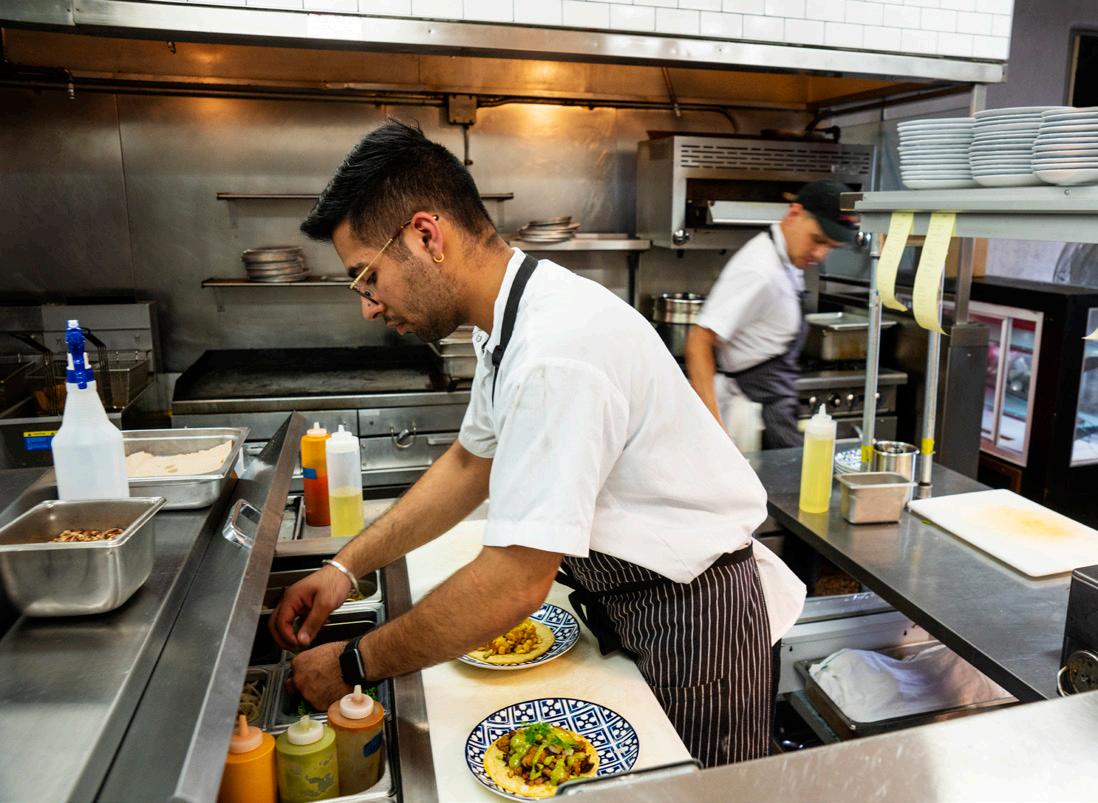Navigating supply chain issues
Insights to navigate shortages and surge to recovery


Insights to navigate shortages and surge to recovery

During this time, communication is key. Operators should remain in close contact with their distributor’s account manager for feedback on how to stay ahead of supply chain issues. For instance, operators can review menus with their distributor to identify items at risk for upcoming outages, then work around them. They may also seek advice on how/where to reduce menu options to limit these risks as well. If their distributor or purchasing partner offers on-staff culinary expertise, those advisors can assist with menu ideation, substitution suggestions and identifying multiple-use ingredients to save on costs while creating a shortageresistant menu.
An intuitive extension of smarter inventory management and proactive maintenance is keeping regular replacements in inventory for every item critical to the business. This could mean duplicate equipment, spare uniforms and linens, or other supplies that would hamper operations if unavailable for 6 to 8 weeks.
RTU products are a simple and effective way for hotel managers and operators to cut down on labor and ingredient needs without hindering guest experience. For instance, managers can purchase precut produce, or items like RTU muffins, desserts, sauces and soups that can be served as is — without additional prep. By employing RTU products, operators minimize preparation steps and increase their resistance to ingredient-based shortages.

Insights to find, attract and hire a stable team
It’s clear from the data: demand for labor is surging beyond any point in recent history.
According to a fall 2021 report on job posting data from Indeed, employers are seeking workers at a rate 46.1% higher than at the pre-pandemic baseline. Nearly 3% of job posts are now “urgent” — a number that may seem low, but is approximately 60% higher than mid-2020 figures. Not surprisingly, private sector North American workers saw 3.5% year-over-year wage growth in Q2 2021, the largest since 2007.
These figures are averaged across industries, but the impact is particularly harsh in the leisure and hospitality business. According to Indeed, this segment — along with tourism — lags behind retail, food preparation and all other sectors in hiring growth as of October 2021. This is despite leisure and hospitality seeing the highest quit rates of any sector at just over 4% in early 2020 and well past 6% in August 2021.
46.1% higher demand for workers
60% higher “urgent” job posts
3.5% year-over-year wage growth
4 to 6% higher quit rates for leisure and hospitality industries

Temporary labor support has always been an option for employers, but its utility is more apparent as hospitality managers continue to face labor shortfalls.
In particular, managers can now consider sourcing temporary labor support — planned or on-demand — through partnerships with GPO partners like Entegra. In addition to securing lower prices on physical goods, these partners can connect hotels and other businesses to discounted rates on services that include temporary labor.
For example, Entegra’s planned labor offerings include services through:
All Team: A specialized recruiting and screening provider for skilled hourly workers. Its Food Team division is specifically geared to food service and hospitality staffing.
Anserteam: A WBENC-certified provider with expertise in contingent workforce solutions, staffing from 293 offices in North America.
Trueblue, Inc.: The leading provider of bluecollar staffing across general labor and skilled trades, including logistics, drivers, technicians and more.
Entegra also offers on-demand labor support through Instawork, a provider of 500,000 professionals vetted from 20 metropolitan US areas. Instawork’s background is rooted in hospitality, making the company a strong resource for all use cases for hotel managers, from single call-outs to full-time staffing.



Insights to engage and grow an existing workforce

While raising wages will certainly move the needle with prospective employees, that’s not always possible — especially for operators struggling with already-thin margins. They can instead focus on unique incentives — those that can’t or won’t be easily matched elsewhere — to stand out for employees. Consider perks like room discounts for family travel, free or discounted meals during work hours, transportation allowance, childcare assistance or discounts at local partner businesses. These benefits have a clear monetary value, but also feel irreplaceable to workers who might otherwise consider similarly compensated roles.
In addition to flexibility around remote work, companies should consider offering programs that clearly demonstrate a commitment to work/life balance and mental health. This can take the form of mental health day allotments, greater PTO packages, free quarterly lunches or blocked-out time free from meetings and check-ins. Additionally, workers who balance their time wisely should be rewarded, potentially in the form of additional compensation.
Of surveyed people who left previous jobs, 93% said they would have stayed if the company had invested more in their development and career growth. Workers who believe their employers have a meaningful long-term plan for them are far less likely to leave, and far more likely to become engaged employees who reinforce positive impressions about the workplace to their peers.
Managers should not only acknowledge today’s achievements, but demonstrate to employees how those achievements will lead to greater opportunity in the coming months and years. National associations have recommended managers create and execute career path plans employees can expect to progress through if they stay with the company.
